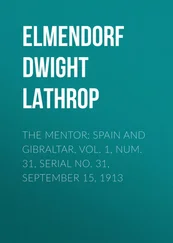John Dyke - The Mentor - Rembrandt, Vol. 4, Num. 20, Serial No. 120, December 1, 1916
Здесь есть возможность читать онлайн «John Dyke - The Mentor - Rembrandt, Vol. 4, Num. 20, Serial No. 120, December 1, 1916» — ознакомительный отрывок электронной книги совершенно бесплатно, а после прочтения отрывка купить полную версию. В некоторых случаях можно слушать аудио, скачать через торрент в формате fb2 и присутствует краткое содержание. Жанр: foreign_antique, foreign_prose, на английском языке. Описание произведения, (предисловие) а так же отзывы посетителей доступны на портале библиотеки ЛибКат.
- Название:The Mentor: Rembrandt, Vol. 4, Num. 20, Serial No. 120, December 1, 1916
- Автор:
- Жанр:
- Год:неизвестен
- ISBN:нет данных
- Рейтинг книги:3 / 5. Голосов: 1
-
Избранное:Добавить в избранное
- Отзывы:
-
Ваша оценка:
- 60
- 1
- 2
- 3
- 4
- 5
The Mentor: Rembrandt, Vol. 4, Num. 20, Serial No. 120, December 1, 1916: краткое содержание, описание и аннотация
Предлагаем к чтению аннотацию, описание, краткое содержание или предисловие (зависит от того, что написал сам автор книги «The Mentor: Rembrandt, Vol. 4, Num. 20, Serial No. 120, December 1, 1916»). Если вы не нашли необходимую информацию о книге — напишите в комментариях, мы постараемся отыскать её.
The Mentor: Rembrandt, Vol. 4, Num. 20, Serial No. 120, December 1, 1916 — читать онлайн ознакомительный отрывок
Ниже представлен текст книги, разбитый по страницам. Система сохранения места последней прочитанной страницы, позволяет с удобством читать онлайн бесплатно книгу «The Mentor: Rembrandt, Vol. 4, Num. 20, Serial No. 120, December 1, 1916», без необходимости каждый раз заново искать на чём Вы остановились. Поставьте закладку, и сможете в любой момент перейти на страницу, на которой закончили чтение.
Интервал:
Закладка:
John C. Van Dyke
The Mentor: Rembrandt, Vol. 4, Num. 20, Serial No. 120, December 1, 1916
Christmas Giving

The old question – What shall we give? Too often answered by giving the easiest thing. “There, that’s off my mind for another year!” Yes, off your mind – but how does your heart feel when your friend sends you something that shows that he has cherished a little special thought of you?
Christmas giving may be a blessing or a blight – according to the spirit of the giver. It is a blessing when it carries with it a thought that honors the one that gives and benefits the one that receives.

“Benefit is the end of Nature,” says Emerson, “and he is great who confers the most benefits. Beware of good staying in your hand. Pay it away quickly to someone.”
Thousands of you tell me in the daily mail how The Mentor benefits you. Can you give a better gift to your friend than this same benefit? If we benefit you, we can also benefit him. With whole heart we pledge full service to him as to you. Give, then, this Christmas, The Mentor and all its service to your friend. Your message of friendship will be repeated to him twice a month throughout the year.
THE EDITOR.
IN THE HERMITAGE, PETROGRAD
SOBIESKI – Portrait by Rembrandt
REMBRANDT
Early Years
Sometimes it is difficult to learn the truth about a great man. This is particularly so in the case of one who lived three centuries ago; for in those days people were not as careful to keep records as they are today. For years the great painter Rembrandt was regarded as having been ignorant, boorish, and avaricious. Fables making him out to be such a character sprang up without any foundation. It is only within the last fifty years that we have come to know the true Rembrandt, and to realize that he had profound sympathy, a powerful imagination, and originality of mind, and that he was a poet as well as a painter, an idealist and also a realist. He has justly been called “the Shakespeare of Holland.”
Rembrandt Harmens van Rijn – for that is his full name – was born at Leyden, a town near Amsterdam, in Holland, on July 15, 1605. Leyden is famous in history as the birthplace of many great artists and other men of renown. Rembrandt’s home overlooked the river Rhine. He was the son of a well-to-do miller, and his parents were ambitious that Rembrandt enter the law, for his older brothers had been sent into trade.
At that time Holland was entering upon her great career of national enterprise. Science and literature flourished, poetry and the stage were cultivated by her people, and art was made welcome in every town, large and small. So Rembrandt, after he had been sent to the high school at Leyden, decided to become a painter. For already within him he felt the first urgings of genius.
Accordingly, when Rembrandt was only twelve or thirteen years old, his father allowed him to become a pupil of Jacob van Swanenburch, a painter of no great ability, who, however, enjoyed some reputation because he had studied in Italy. Three years later the boy was placed under Pieter Lastman, of Amsterdam, who was a much better artist and teacher. Authorities differ as to how long Rembrandt remained with Lastman. One says that he was his pupil until he was nineteen years old; another believes that he studied with him for only six months. At any rate, sometime after 1623 Rembrandt returned to the home of his parents at Leyden.
During these first years of his artistic life, Rembrandt worked hard. He painted pictures of almost everyone he saw – beggars, cripples, and in short every picturesque face and form of which he could get hold. Life, character, and special lighting effects were his principal concern. Frequently he used his mother for a model, and from these portraits we can trace his strong resemblance to her. The young artist also liked to paint his father and sisters; and by the number of portraits he painted of himself, we can see that from the very beginning he worked hard to master every form of expression, learning to draw the human face as it appeared not only to the casual observer, but also to one who read the character within. It is said that during his lifetime Rembrandt painted nearly sixty portraits of himself.
Time went by, and the young artist of Leyden was attracting the attention of art lovers in the great metropolis of Amsterdam. Some of them urged him to move there; and feeling that he was now strong enough to stand alone, Rembrandt rented a large house in Amsterdam and removed there in 1631. He divided the upper part of his house into small studios, and there he worked and taught. His pupils were many and from wealthy families. From this teaching Rembrandt derived a large income.
Fortune smiled upon him. At one bound he leaped into the position of the leading portrait painter of Amsterdam. Numerous commissions for portraits flowed in upon him, and during the first few years of his residence there he painted at least forty. When he was only twenty-six years old, in 1632, he painted the “Anatomy Lesson,” a picture that made an enormous sensation, and holds its place today as one of Rembrandt’s masterpieces.
The year 1634 was one of the happiest in Rembrandt’s life. He was then at the beginning of a successful artistic career, and it was at that time that he married Saskia van Ulenburg, a beautiful Frisian maiden. Saskia brought him love and wealth. Eight years of prosperity and sunshine followed their union.
Rembrandt and his wife were a joyous pair. They had four children, a boy and two girls who died in infancy – and a son, Titus, who grew to man’s estate.

DETAIL OF THE ANATOMY LESSON
By Rembrandt
IN THE HAGUE MUSEUM
REMBRANDT
The Master Painter
The year 1640 marks the beginning of what may be termed the second period of Rembrandt’s life and work. It was during these years that success and happiness were his. From then until 1654 Rembrandt worked in what has been called his “second manner.” His art grew in power, and the coldness of his “first manner” had disappeared. He had passed through a period of exaggerated expression and had come to a truer, calmer form of painting. It is interesting to compare his own portrait painted in 1640 with the earlier portraits of himself. This painting portrays a man strong and robust, with powerful head, determined chin, and keen, penetrating eyes. This was the Rembrandt of that period, the man confidently independent and careless as to his popularity as an artist.
Rembrandt had now many pupils. He had bought a house in Amsterdam, and had placed in it a great collection of paintings and engravings. At that time the artist was living a life of simple domesticity, happy with his wife and children. His friends were many, and his interests were large.
Rembrandt’s mother died in 1640, and two years later the great sorrow of his life came upon him. His wife Saskia died. This changed everything for him. The events of his latter days are clouded in obscurity.
Читать дальшеИнтервал:
Закладка:
Похожие книги на «The Mentor: Rembrandt, Vol. 4, Num. 20, Serial No. 120, December 1, 1916»
Представляем Вашему вниманию похожие книги на «The Mentor: Rembrandt, Vol. 4, Num. 20, Serial No. 120, December 1, 1916» списком для выбора. Мы отобрали схожую по названию и смыслу литературу в надежде предоставить читателям больше вариантов отыскать новые, интересные, ещё непрочитанные произведения.
Обсуждение, отзывы о книге «The Mentor: Rembrandt, Vol. 4, Num. 20, Serial No. 120, December 1, 1916» и просто собственные мнения читателей. Оставьте ваши комментарии, напишите, что Вы думаете о произведении, его смысле или главных героях. Укажите что конкретно понравилось, а что нет, и почему Вы так считаете.












